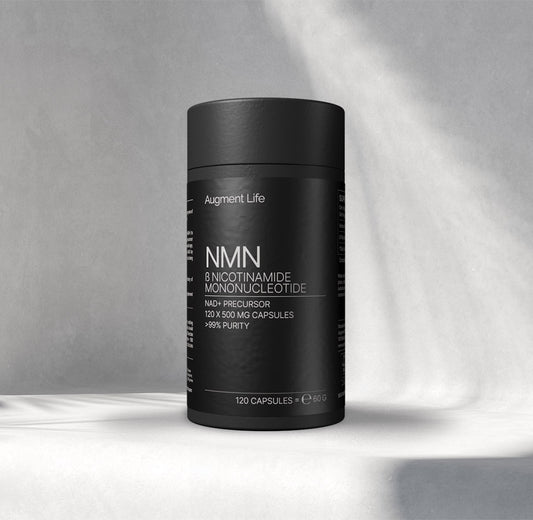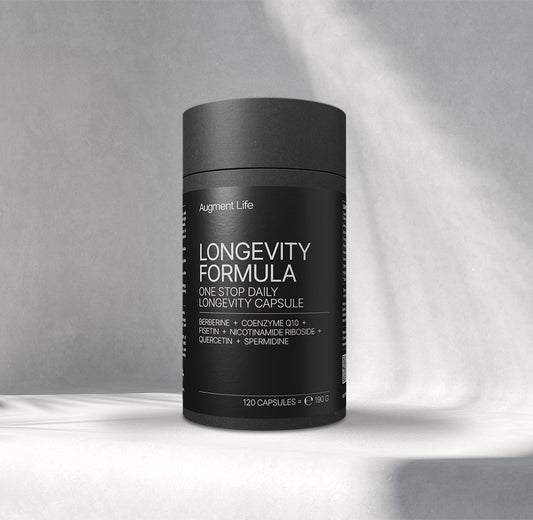L'invecchiamento, in sostanza, è il processo di graduale deterioramento del corpo umano e dei suoi componenti nel tempo. Con nostro grande dispiacere, l'invecchiamento rappresenta da tempo un ostacolo insormontabile alla ricerca dell'uomo di una vita più lunga e vitale. Le attuali teorie sull'invecchiamento si concentrano su fattori chiave come metabolismo, stress ossidativo, disfunzione mitocondriale e cambiamenti epigenetici.
I moderni progressi tecnologici e le attuali pratiche hanno portato a eccedenze alimentari nelle nazioni industrializzate. Tuttavia, mentre molte delle nazioni industrializzate hanno risolto il problema della fame, questa imponente eccedenza alimentare ha aumentato drasticamente i tassi di obesità. L'eccessivo aumento di peso, l'obesità e l'aumento della massa grassa sono direttamente collegati a tassi più elevati di malattie e cancro, spesso esacerbati da disturbi metabolici legati all'età.
Nonostante tutte le conseguenze della vita moderna, le persone in tutto il mondo stanno invecchiando più che mai. Di conseguenza, le popolazioni di tutte le età cercano un'ampia varietà di prodotti naturali e approcci alternativi nella speranza di vivere una vita più lunga e sana. Ciò ha spinto incessanti sforzi di ricerca per scoprire i segreti della longevità e della regolazione metabolica1.
Restrizione Calorica
Una delle teorie fondamentali sul processo di invecchiamento ruota attorno all'azione sul metabolismo. La restrizione calorica (CR) è il processo mediante il quale un organismo riceve un apporto calorico ridotto rispetto al suo fabbisogno calorico normalizzato ed è un approccio fondamentale nella ricerca metabolica e sull'invecchiamento2.
Riducendo l'apporto calorico in vari organismi, gli scienziati hanno scoperto una correlazione sostanziale tra l'aumento della durata della vita e la riduzione calorica in molti organismi diversi (ad esempio, topi, primati, insetti, ecc.)2-4. Sebbene gli studi clinici sull'uomo abbiano avuto risultati positivi per quanto riguarda la CR, riuscire a far sì che i pazienti non mollassero tali studi prima che essi fossero conclusi è risultato problematico2, 4.
Gli esseri umani si sono evoluti per consumare e immagazzinare calorie e, comprensibilmente, andare contro questi istinti non ci interessa. Tuttavia, oggi sappiamo che la restrizione calorica e altri cambiamenti metabolici possono migliorare i sintomi delle malattie legate all'invecchiamento e aumentare la durata della vita2.
La CR è in grado di offrire molti benefici:
- aumento dell'omeostasi del glucosio
- riduzione dello stress ossidativo,
- cambiamenti positivi nell'espressione genica
- aumento della proliferazione cellulare5.
Le difficoltà nella ricerca sulla CR in ambito clinico hanno portato gli scienziati a studiare composti specifici in grado di imitarne l'effetto nel nostro organismo. Queste molecole sono chiamate mimetici della restrizione calorica (CR)5.
Mimetici della CR
Come approccio alternativo alla CR, i mimetici della CR, sia sintetici che naturali, sono stati ampiamente studiati per il loro potenziale di imitare i desiderabili benefici metabolici della CR. Una ricerca recente ha esaminato nuove possibilità per i mimetici della CR basati sulla nutrizione, volti ad alleviare le conseguenze negative dell'obesità e dell'invecchiamento.
Di seguito, approfondiamo alcune delle ricerche più aggiornate e gli ultimi progressi nei mimetici della CR. Nell'ultimo decennio, la ricerca ha ripetutamente identificato il potenziale dei mimetici della CR in un'ampia varietà di tessuti, organi e processi metabolici fondamentali per il mantenimento della salute e dell'omeostasi durante tutto il corso della vita, inclusi ma non limitati a:
- Obesità/Tessuto Adiposo6, 7
- Infiammazione/Stress Ossidativo8
- Salute del Microbiota Intestinale9
- Malattia del Fegato Grasso Non Alcolico10
- Funzione del muscolo scheletrico11
- Omeostasi del Glucosio12
- Salute cardiovascolare12
Di seguito, mi concentrerò su diversi prodotti e composti vegetali importanti e ben studiati, evidenziandone il potenziale come mimetici CR.
Resveratrolo
Il Resveratrolo (RSV) è un polifenolo di origine vegetale presente in alte concentrazioni nell'uva, ampiamente studiato per il suo potenziale come mimetico della CR13. È stato più volte dimostrato che l'RSV attiva la SIRT1 e altre proteine sirtuine, che sono associate a una maggiore durata della vita e a una migliore salute metabolica, simili ai benefici osservati con la CR14.
Questa attivazione da sola può portare a vari benefici, tra cui:
- una migliore sensibilità all'insulina
- una migliore funzione mitocondriale
- un aumento del metabolismo dei grassi.
A diretto supporto di ciò, uno studio ha scoperto che l'RSV potrebbe potenzialmente imitare gli effetti della CR riducendo i livelli di citochine plasmatiche, promuovendo la lipolisi e l'assorbimento degli acidi grassi e potenzialmente inibendo il percorso NF-kB nei ratti obesi. Ciò ha portato a una riduzione del peso corporeo e a livelli ridotti di biomarcatori infiammatori nel tessuto adiposo7. In un altro studio clinico in doppio cieco, l'integrazione di trans-resveratrolo ha alterato la segnalazione genetica degli adipociti e ridotto le dimensioni delle cellule adipose addominali negli uomini obesi di età compresa tra 40 e 65 anni6.
Sebbene il potenziale anti-obesogeno del resveratrolo (RSV) sia promettente, la ricerca ha anche dimostrato che il RSV potrebbe essere in grado di agire sulle comorbidità della steatosi epatica non alcolica (NAFLD) e delle malattie cardiovascolari. Uno studio clinico randomizzato in doppio cieco ha rilevato che l’integrazione quotidiana di RSV ha ridotto l’infiammazione e i danni alle cellule epatiche10. Inoltre, lo studio ha suggerito che il resveratrolo potrebbe essere più efficace dei cambiamenti nello stile di vita come strategia di intervento nei pazienti con NAFLD10.
Come ampiamente dimostrato, l’integrazione con RSV può anche fornire potenziali benefici cardioprotettivi per il cuore in età avanzata e può ridurre i fattori di rischio cardiovascolare grazie alle sue proprietà antinfiammatorie, antiossidanti, antiaggreganti piastriniche e ipolipemizzanti15. Per quanto riguarda il diabete e la sindrome metabolica, uno studio recente ha scoperto che il RSV potrebbe aver contribuito a un moderato miglioramento della sensibilità all’insulina nei topi, come dimostrato da livelli ridotti di insulina a digiuno e dopo carico di glucosio16.
Resveratrolo - controversie
Sebbene queste evidenze supportino fortemente il RSV come mimetico della restrizione calorica (CR), gli studi clinici che ne indagano gli effetti hanno spesso prodotto dati contrastanti, rendendo difficile trarre conclusioni definitive17. Queste incongruenze e variazioni potrebbero essere attribuite a fattori quali:
- differenze nei dosaggi,
- qualità del RSV,
- popolazioni studiate,
- durata del trattamento.
Se desideri provare l’integrazione con RSV, puoi acquistarlo tramite il nostro webshop:
Estratto di Tè Verde
L’estratto di tè verde è un altro integratore a base vegetale ampiamente studiato per i suoi molteplici benefici per la salute. Come il RSV, anche l’estratto di tè verde e i suoi composti isolati sono stati analizzati per il loro potenziale anti-obesogeno e mimetico della CR18.
In questi studi, le evidenze hanno mostrato che tali composti possono ridurre l’adiposità, migliorare il profilo metabolico e aumentare la “brunificazione” del tessuto adiposo in topi alimentati con diete ricche di grassi18. A supporto di ciò, l’estratto di tè verde ha anche dimostrato di migliorare la sensibilità all’insulina, ridurre lo stress ossidativo e l’infiammazione, promuovere l’ossidazione dei grassi, attivare le sirtuine e migliorare la longevità cellulare19, 20.
Una recente revisione sistematica e meta-analisi di studi clinici ha rivelato che l’integrazione con tè verde ha promosso riduzioni significative del peso corporeo e dell’IMC in soggetti obesi21. Inoltre, sono state osservate riduzioni della circonferenza vita nei pazienti obesi che hanno assunto tè verde in dosi ≥800 mg/giorno per meno di 3 mesi21.
Nel complesso, questi risultati suggeriscono che il tè verde può essere un utile complemento a una dieta equilibrata e a un regime di esercizio fisico sia per le persone anziane sia per quelle obese.
Se desideri provare l’estratto di tè verde, puoi acquistarlo dal nostro webshop:
Quercetina
La quercetina, un altro polifenolo naturale di origine vegetale, ha attirato notevole attenzione come potenziale mimetico della CR grazie alle sue proprietà uniche. Come il RSV, la quercetina può potenzialmente favorire la riparazione del DNA e la regolazione metabolica attraverso l’attivazione delle sirtuine22.
Come dimostrato, la ricerca ha evidenziato i benefici anti-cancro, anti-invecchiamento, antiossidanti, antivirali e neuroprotettivi della quercetina23. In uno studio molto recente, è stato analizzato il potenziale terapeutico della quercetina contro il COVID-19 in fase iniziale. In modo affascinante, lo studio ha rilevato che la quercetina potrebbe modulare la risposta iperinfiammatoria e aumentare la clearance del SARS-CoV-2 nei soggetti clinici24.
Tuttavia, non ci sono ancora prove che la quercetina sia un vero mimetico della CR. Ha un forte potenziale per agire in modo simile al RSV, ma sono necessarie ulteriori ricerche, soprattutto in ambito clinico.
Conclusione
I mimetici naturali della restrizione calorica hanno guadagnato attenzione per il loro potenziale nell’affrontare sia l’invecchiamento che l’obesità. Offrono anche benefici anti-obesogeni migliorando la salute metabolica, riducendo l’infiammazione e potenzialmente aiutando nella gestione del peso. L’estratto di tè verde ha mostrato risultati promettenti nella riduzione del peso corporeo, dell’IMC e della circonferenza vita, rendendolo uno strumento prezioso per combattere l’obesità e possibilmente prolungare la longevità.
Oltre ai mimetici naturali della CR menzionati in questo articolo, molti altri composti hanno mostrato potenziale nella ricerca sull’età e l’obesità.
Come descritto nel seguente elenco, si può chiaramente osservare il potenziale anti-invecchiamento condiviso tra la CR e i suoi mimetici.
- Regolazione metabolica (bilancio energetico, sintesi proteica, AMPK/mTOR) – CR, RSV, Quercetina, Estratto di tè verde2, 25, 26
- Traduzione genetica e funzione del genoma – CR, RSV, Estratto di tè verde27
- Stress ossidativo e infiammazione – CR, RSV, Quercetina, Estratto di tè verde12, 28
I mimetici della CR offrono strade entusiasmanti per la ricerca futura nella ricerca di una longevità prolungata e approcci olistici al miglioramento della salute metabolica.
Riferimenti
- Steele CB, Thomas CC, Henley SJ, Massetti GM, Galuska DA, Agurs-Collins T, et al. Vital Signs: Trends in Incidence of Cancers Associated with Overweight and Obesity - United States, 2005-2014. MMWR Morbidity and mortality weekly report 2017; 66: 1052-1058, doi:10.15585/mmwr.mm6639e1.
- Balasubramanian P, Howell PR, Anderson RM. Aging and Caloric Restriction Research: A Biological Perspective With Translational Potential. EBioMedicine 2017; 21: 37-44, doi:10.1016/j.ebiom.2017.06.015.
- Whitaker R, Faulkner S, Miyokawa R, Burhenn L, Henriksen M, Wood JG, et al. Increased expression of Drosophila Sir 2 extends life span in a dose-dependent manner. Aging (Albany NY) 2013; 5: 682-691, http://www.ncbi.nlm.nih.gov/pmc/articles/PMC3808700/.
- Lees H, Walters H, Cox LS. Animal and human models to understand ageing. Maturitas 2016; 93: 18-27, doi:https://doi.org/10.1016/j.maturitas.2016.06.008.
- Gillespie ZE, Pickering J, Eskiw CH. Better Living through Chemistry: Caloric Restriction (CR) and CR Mimetics Alter Genome Function to Promote Increased Health and Lifespan. Frontiers in Genetics 2016; 7: 142, doi:10.3389/fgene.2016.00142.
- Konings E, Timmers S, Boekschoten MV, Goossens GH, Jocken JW, Afman LA, et al. The effects of 30 days resveratrol supplementation on adipose tissue morphology and gene expression patterns in obese men. International Journal of Obesity 2013; 38: 470, doi:10.1038/ijo.2013.155.
- Gómez-Zorita S, Fernández-Quintela A, Lasa A, Hijona E, Bujanda L, Portillo MP. Effects of resveratrol on obesity-related inflammation markers in adipose tissue of genetically obese rats. Nutrition 2013; 29: 1374-1380, doi:https://doi.org/10.1016/j.nut.2013.04.014.
- Gabandé-Rodríguez E, Gómez de Las Heras MM, Mittelbrunn M. Control of Inflammation by Calorie Restriction Mimetics: On the Crossroad of Autophagy and Mitochondria. Cells 2019; 9, doi:10.3390/cells9010082.
- Shintani T, Shintani H, Sato M, Ashida H. Calorie restriction mimetic drugs could favorably influence gut microbiota leading to lifespan extension. Geroscience 2023, doi:10.1007/s11357-023-00851-0.
- Faghihzadeh F, Adibi P, Rafiei R, Hekmatdoost A. Resveratrol supplementation improves inflammatory biomarkers in patients with nonalcoholic fatty liver disease. Nutrition Research 2014; 34: 837-843, doi:10.1016/j.nutres.2014.09.005.
- Zhou G, Myers R, Li Y, Chen Y, Shen X, Fenyk-Melody J, et al. Role of AMP-activated protein kinase in mechanism of metformin action. The Journal of clinical investigation 2001; 108: 1167-1174, doi:10.1172/jci13505.
- Madeo F, Carmona-Gutierrez D, Hofer SJ, Kroemer G. Caloric Restriction Mimetics against Age-Associated Disease: Targets, Mechanisms, and Therapeutic Potential. Cell Metabolism 2019; 29: 592-610, doi:https://doi.org/10.1016/j.cmet.2019.01.018.
- Chung JH, Manganiello V, Dyck JR. Resveratrol as a calorie restriction mimetic: therapeutic implications. Trends Cell Biol 2012; 22: 546-554, doi:10.1016/j.tcb.2012.07.004.
- Iside C, Scafuro M, Nebbioso A, Altucci L. SIRT1 Activation by Natural Phytochemicals: An Overview. Front Pharmacol 2020; 11: 1225, doi:10.3389/fphar.2020.01225.
- Pang L, Jiang X, Lian X, Chen J, Song E-F, Jin L-G, et al. Caloric restriction-mimetics for the reduction of heart failure risk in aging heart: with consideration of gender-related differences. Military Medical Research 2022; 9: 33, doi:10.1186/s40779-022-00389-w.
- Günther I, Rimbach G, Mack CI, Weinert CH, Danylec N, Lüersen K, et al. The Putative Caloric Restriction Mimetic Resveratrol has Moderate Impact on Insulin Sensitivity, Body Composition, and the Metabolome in Mice. Mol Nutr Food Res 2020; 64: e1901116, doi:10.1002/mnfr.201901116.
- Berman AY, Motechin RA, Wiesenfeld MY, Holz MK. The therapeutic potential of resveratrol: a review of clinical trials. npj Precision Oncology 2017; 1: 35, doi:10.1038/s41698-017-0038-6.
- Lee MS, Kim CT, Kim Y. Green tea (-)-epigallocatechin-3-gallate reduces body weight with regulation of multiple genes expression in adipose tissue of diet-induced obese mice. Annals of nutrition & metabolism 2009; 54: 151-157, doi:10.1159/000214834.
- Chacko SM, Thambi PT, Kuttan R, Nishigaki I. Beneficial effects of green tea: a literature review. Chin Med 2010; 5: 13, doi:10.1186/1749-8546-5-13.
- Vilella R, Izzo S, Naponelli V, Savi M, Bocchi L, Dallabona C, et al. In Vivo Treatment with a Standardized Green Tea Extract Restores Cardiomyocyte Contractility in Diabetic Rats by Improving Mitochondrial Function through SIRT1 Activation. Pharmaceuticals (Basel) 2022; 15, doi:10.3390/ph15111337.
- Lin Y, Shi D, Su B, Wei J, Găman MA, Sedanur Macit M, et al. The effect of green tea supplementation on obesity: A systematic review and dose-response meta-analysis of randomized controlled trials. Phytother Res 2020; 34: 2459-2470, doi:10.1002/ptr.6697.
- Iside C, Scafuro M, Nebbioso A, Altucci L. SIRT1 Activation by Natural Phytochemicals: An Overview [Review]. Frontiers in Pharmacology 2020; 11, doi:10.3389/fphar.2020.01225.
- Yessenkyzy A, Saliev T, Zhanaliyeva M, Masoud AR, Umbayev B, Sergazy S, et al. Polyphenols as Caloric-Restriction Mimetics and Autophagy Inducers in Aging Research. Nutrients 2020; 12, doi:10.3390/nu12051344.
- Di Pierro F, Khan A, Iqtadar S, Mumtaz SU, Chaudhry MNA, Bertuccioli A, et al. Quercetin as a possible complementary agent for early-stage COVID-19: Concluding results of a randomized clinical trial. Front Pharmacol 2022; 13: 1096853, doi:10.3389/fphar.2022.1096853.
- Ahn J, Lee H, Kim S, Park J, Ha T. The anti-obesity effect of quercetin is mediated by the AMPK and MAPK signaling pathways. Biochem Biophys Res Commun 2008; 373: 545-549, doi:10.1016/j.bbrc.2008.06.077.
- Mousavi A, Vafa M, Neyestani T, Khamseh M, Hoseini F. The effects of green tea consumption on metabolic and anthropometric indices in patients with Type 2 diabetes. J Res Med Sci 2013; 18: 1080-1086.
- Gillespie ZE, Pickering J, Eskiw CH. Better Living through Chemistry: Caloric Restriction (CR) and CR Mimetics Alter Genome Function to Promote Increased Health and Lifespan. Front Genet 2016; 7: 142, doi:10.3389/fgene.2016.00142.
- Li Y, Yao J, Han C, Yang J, Chaudhry MT, Wang S, et al. Quercetin, Inflammation and Immunity. Nutrients 2016; 8: 167, doi:10.3390/nu8030167.











